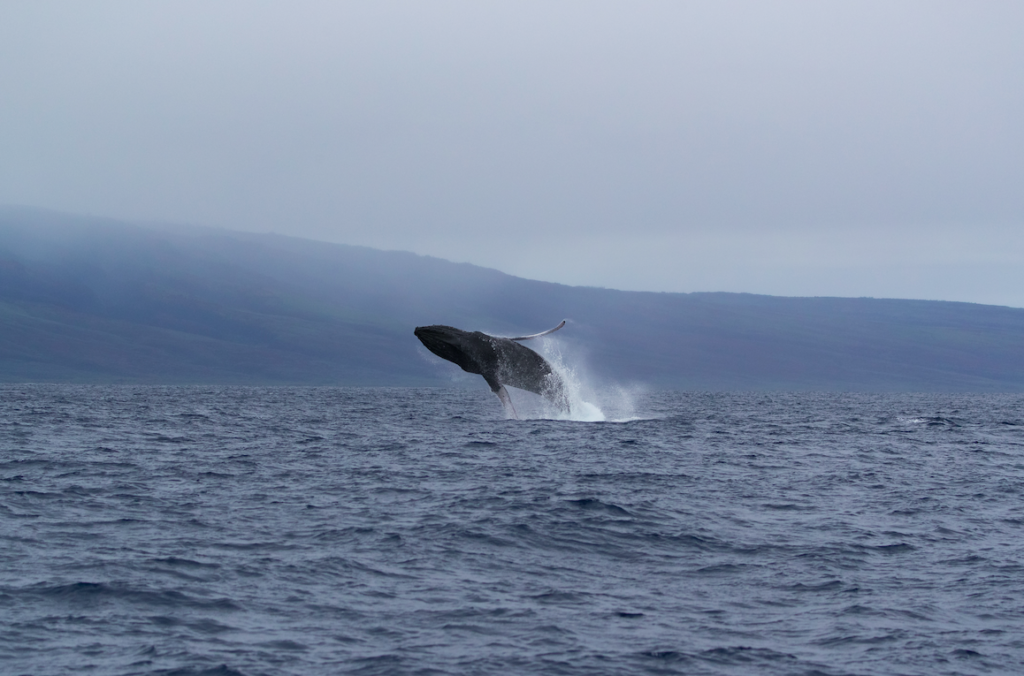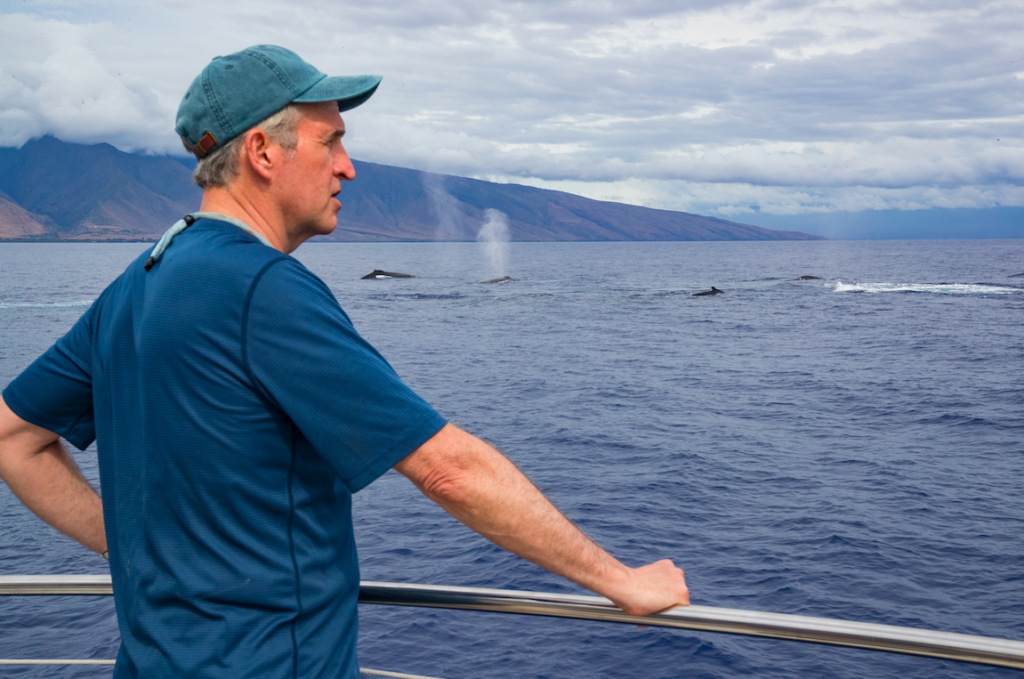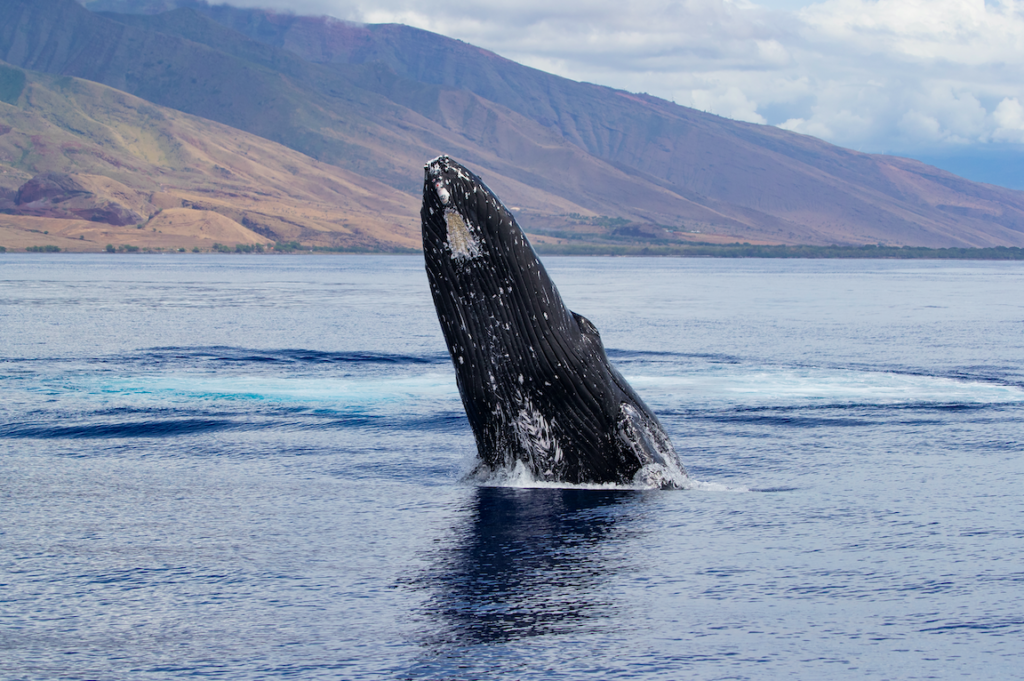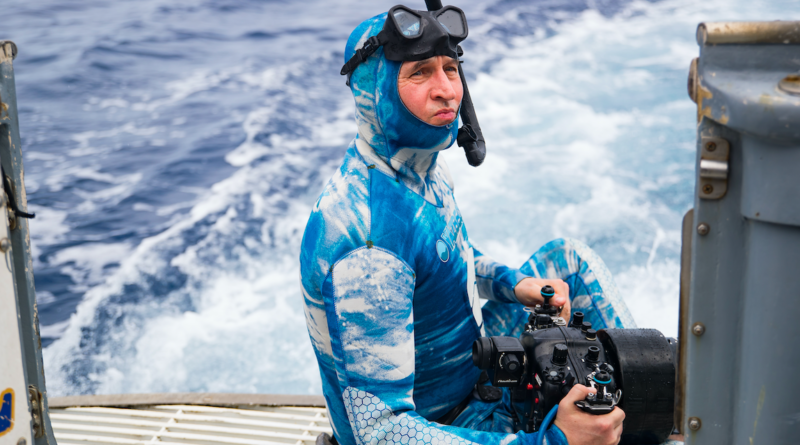INTERVIEW: Brian Skerry, on his life beneath the surface
Photo: Brian Skerry is a photojournalist who has been working for National Geographic for 22 years. Photo courtesy of National Geographic / ABC / Steve De Need / Provided by press site with permission.
Brian Skerry’s excitement level runs counter to whatever sea level he might find himself at. When he puts on his diving equipment and heads beneath the surface of the world’s oceans, his happiness and sense of adventure skyrocket, like an aircraft at take off. As he himself descends beneath the surface, his elation ascends.
That’s been the life of this famous photojournalist for decades. He is a go-to documenter of marine life for National Geographic magazine and channel, and his exploration will be one of the stories on display for the network’s special Earth Day programming.
Born Wild: The Next Generation, airing Wednesday, April 22 at 8 p.m., follows National Geographic explorers and fellows as they search planet Earth for unique and inspiring tales of animal creatures being born. Skerry’s assignment is humpback whales off the coast of Hawaii, and what he finds in those crystal-blue waters is every bit worthy of the Nat Geo brand.
Skerry’s connection to Nat Geo goes back some time, but its roots can be found in the late-1970s when he took up diving at the young age of 15 years old.
“In the beginning I just wanted to be an ocean explorer,” Skerry said in a recent phone interview. “I wanted to be out there diving with sharks and whales, and doing all kinds of cool things, and it was shortly after I started diving, I attended a diving conference in Boston. And I saw photographers and documentary filmmakers presenting their work, and I had an epiphany. I decided that that’s how I wanted to explore the ocean, was with a camera. It was a very lofty dream, but right from the start, I wanted to work for National Geographic.”
[Read Hollywood Soapbox’s interview with Dr. Jane Goodall.]
Success with the world-famous magazine didn’t come overnight. He had to study photography, photojournalism, film and other aspects of visual storytelling in college, but he eventually put in his time and rose through the ranks of the highly competitive industry. Then, in 1998, he received his first assignment for the magazine.
“So I’ve been with them for 22 years doing ocean stories,” he said proudly. “I think I just started my 29th story for the magazine, and I would say maybe 25 or 26 of the 29 have been my idea. So it’s about me doing research, proposing stories if they like it, and I get to go do it. There’s also been an evolution in that work, in the sense that it started out just wanting to do more celebratory stuff, and then I saw a lot of problems occuring in the ocean. So I wanted to turn my cameras to those things as well.”
Throughout his time with Nat Geo, he has had many acclaimed projects and honors, including in 2014 being named a National Geographic Photography Fellow and in 2017 being named the Rolex National Geographic Explorer of the Year. His assignments have allowed him to document a plethora of species, including everything from harp seals to predatory sharks.
“It had been my dream for decades to become a National Geographic photographer,” Skerry said. “The odds are really slim. In hindsight, I look back, and the odds for me were probably a billion-to-one. I came from this little textile-mill town, a little working-class town. I didn’t know anybody that was really a photographer. I didn’t know anybody that was certainly an underwater photographer. I didn’t have the resources to travel. I was 26 years old before I got on an airplane, and that was just to go to Florida to go diving. So I was competing against a lot of people [who] had a lot more resources and could travel around the world and all this great stuff, but when I got that first assignment, it was a victory. It was a validation, like, OK, I can do this.”
Skerry said that the day he received his first assignment was likely the greatest day of his professional life. However, it also began a period of time that was the most nerve-wracking. He needed to deliver the goods.
“You have to get the photographs, and National Geographic is famous for saying, ‘We don’t publish excuses,’” Skerry said. “They don’t care if there was a hurricane or if the boat sank. No matter what happened, you either got it, or you didn’t. In many respects, I often equate my career to that of a professional athlete. I have to be Tom Brady or somebody out there, but over multiple decades. You’ve got to pretty much win every game. You can have a few bad trips, but you’ve got to get the story. So it’s been fantastic, but you can never rest on your laurels. And you can never take it for granted.”



There are many unique challenges that Skerry faces as an underwater photographer, especially when compared to his terrestrial counterparts. He cannot drive up to an animal scene and hit record. He cannot lug a long lens out to the bush and plant himself far from the action. He needs to be up close and in the water.
“We are working in an alien environment,” he said. “You have to wear life-support equipment when you go into the ocean, or you have to hold your breath to get close to these animals. I often talk about the fact that my terrestrial counterparts, I don’t have the luxury that they do of sitting in a camouflaged blind for maybe a month or more waiting for some elusive animal to wander by, and then using a 600mm lens to get a picture. I have to jump in the water. I can only stay underwater as long as the air supply on my back will last, and in the case of humpback whales for Born Wild, that’s holding my breath maybe a couple minutes. And then I have to get very close. Even in the clearest of water, you can’t use one of those telephoto lenses; it’s just not possible. So I have to get within a couple meters of my subject, and it really comes down to the animals. They have to allow me into their world, but inevitably over the years, over the decades, those moments happen. It doesn’t happen on every trip or certainly every dive, but if you’re persistent, you’re patient, and you hone your skills and learn how to do this stuff, it can be done.”
For Born Wild, Skerry headed to the tranquil waters off Maui, Hawaii — not a bad place to be based. But the assignment in the ocean wasn’t easy because he had to track the migration habits of humpback whales who spend their winters in Hawaii and their summers in Alaska. In their northern habitat, they feed on herring, and then they head south to take part in courtship, mating and calf-ing.
“The female that has a calf, she doesn’t feed for several months,” he said. “She might be there for two or three or even longer months, and during that time, she’s nursing the calf. The calf is drinking up to 100 gallons of milk, this very nutrient-rich, fat-rich milk everyday to put on the weight, and then after a few months, they begin that migration back to Alaska for the summer. Those waters are much colder, so the calf has to be really prepared for that. It’s a really unique situation that occurs in those waters off of Maui, and this year was quite extraordinary. We saw lots of humpback whale moms and calfs, so it was a good year, a little hopeful sign. And that’s communicated in this documentary as well.”
Skerry’s love of whales goes back quite a long time. He has always been inspired by these gargantuan creatures of the sea.
“I’m just fascinated with whales,” Skerry said. “I’m also coming off a three-year project for National Geographic, which will be a four-part series for the Nat Geo channel in 2022 and a magazine story and a book and so forth — all about whale culture — so I think the more we’re learning about whales, the more we understand that they’re very much like us. They have their own languages and dialects. They have parenting techniques and feeding strategies. … Even within the same genetic species, they do things very differently, much the way that humans do, so I think for me as someone who cares about the health of the ocean and the health of the planet, whales are a great ambassador.”
He added: “We have a multi-billion-dollar industry looking at whales, whale-watching around the planet, but folks go on a boat, and they see a whale jump, and then they eat a hot dog, and go home and think that was great. This is an opportunity with a show like Born Wild to go a little deeper, no pun intended, and to really see the relationships between a mom and a calf humpback whale. A female humpback invests a great deal of energy into her calf. There’s a yearlong gestation process, and then after the calf is born, that mom develops a bond that lasts over a year as well. She has to teach her calf all of these behaviors that they’re going to need to live. It’s like humans. We don’t have these innate traits that we’re born with for survival. We have to learn from our mothers or our family, and it’s the same with whales.”
It’s also significant that Born Wild will appear on Earth Day’s 50th anniversary. Skerry said the five-decade history of this special day is not lost on him. For example, the humpback calf that he was able to film will likely live until the 100th anniversary of Earth Day, and he hopes there’s a planet Earth worth celebrating at that point in the future.
“What will our planet look like is going to be up to us,” Skerry said. “I think many of these anthropogenic stresses that the plants and animals of our world are dealing with are going to have change because otherwise our fates are not going to be very good as well.”
By John Soltes / Publisher / John@HollywoodSoapbox.com
Born Wild: The Next Generation, featuring Brian Skerry, will play Nat Geo and Nat Geo WILD Wednesday, April 22 at 8 p.m. It will also be available to stream on Disney+ and Hulu. Click here for more information.

